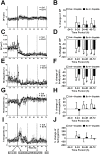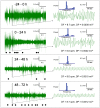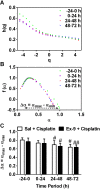Gastric myoelectric activity during cisplatin-induced acute and delayed emesis reveals a temporal impairment of slow waves in ferrets: effects not reversed by the GLP-1 receptor antagonist, exendin (9-39)
- PMID: 29228720
- PMCID: PMC5716760
- DOI: 10.18632/oncotarget.21859
Gastric myoelectric activity during cisplatin-induced acute and delayed emesis reveals a temporal impairment of slow waves in ferrets: effects not reversed by the GLP-1 receptor antagonist, exendin (9-39)
Abstract
Preclinical studies show that the glucagon-like peptide-1 (GLP-1) receptor antagonist, exendin (9-39), can reduce acute emesis induced by cisplatin. In the present study, we investigate the effect of exendin (9-39) (100 nmol/24 h, i.c.v), on cisplatin (5 mg/kg, i.p.)-induced acute and delayed emesis and changes indicative of 'nausea' in ferrets. Cisplatin induced 37.2 ± 2.3 and 59.0 ± 7.7 retches + vomits during the 0-24 (acute) and 24-72 h (delayed) periods, respectively. Cisplatin also increased (P<0.05) the dominant frequency of gastric myoelectric activity from 9.4 ± 0.1 to 10.4 ± 0.41 cpm and decreased the dominant power (DP) during acute emesis; there was a reduction in the % power of normogastria and an increase in the % power of tachygastria; food and water intake was reduced. DP decreased further during delayed emesis, where normogastria predominated. Advanced multifractal detrended fluctuation analysis revealed that the slow wave signal shape became more simplistic during delayed emesis. Cisplatin did not affect blood pressure (BP), but transiently increased heart rate, and decreased heart rate variability (HRV) during acute emesis; HRV spectral analysis indicated a shift to 'sympathetic dominance'. A hyperthermic response was seen during acute emesis, but hypothermia occurred during delayed emesis and there was also a decrease in HR. Exendin (9-39) did not improve feeding and drinking but reduced cisplatin-induced acute emesis by ~59 % (P<0.05) and antagonised the hypothermic response (P<0.05); systolic, diastolic and mean arterial BP increased during the delayed phase. In conclusion, blocking GLP-1 receptors in the brain reduces cisplatin-induced acute but not delayed emesis. Restoring power and structure to slow waves may represent a novel approach to treat the side effects of chemotherapy.
Keywords: GLP-1 receptors; cisplatin; emesis; ferret; gastric myoelectric activity.
Conflict of interest statement
CONFLICTS OF INTEREST The authors do not have any conflicts of interest.
Figures







Similar articles
-
Centrally located GLP-1 receptors modulate gastric slow waves and cardiovascular function in ferrets consistent with the induction of nausea.Neuropeptides. 2017 Oct;65:28-36. doi: 10.1016/j.npep.2017.04.006. Epub 2017 Apr 21. Neuropeptides. 2017. PMID: 28456436
-
Differential hypoglycaemic, anorectic, autonomic and emetic effects of the glucagon-like peptide receptor agonist, exendin-4, in the conscious telemetered ferret.J Transl Med. 2014 Dec 10;12:327. doi: 10.1186/s12967-014-0327-6. J Transl Med. 2014. PMID: 25491123 Free PMC article.
-
Reduced normogastric electrical activity associated with emesis: a telemetric study in ferrets.World J Gastroenterol. 2009 Dec 28;15(48):6034-43. doi: 10.3748/wjg.15.6034. World J Gastroenterol. 2009. PMID: 20027675 Free PMC article.
-
Insights into the central pathways involved in the emetic and behavioural responses to exendin-4 in the ferret.Auton Neurosci. 2017 Jan;202:122-135. doi: 10.1016/j.autneu.2016.09.003. Epub 2016 Sep 14. Auton Neurosci. 2017. PMID: 27692857
-
Oral ondansetron for the control of delayed emesis after cisplatin. Report of a phase II study and a review of completed trials to manage delayed emesis.Cancer. 1992 Aug 15;70(4 Suppl):1012-6. Cancer. 1992. PMID: 1386282 Review.
Cited by
-
An application of deep learning model InceptionTime to predict nausea, vomiting, diarrhoea, and constipation using the gastro-intestinal pacemaker activity drug database (GIPADD).Sci Rep. 2025 Apr 16;15(1):13105. doi: 10.1038/s41598-025-95961-4. Sci Rep. 2025. PMID: 40240387 Free PMC article.
-
Sulprostone-Induced Gastric Dysrhythmia in the Ferret: Conventional and Advanced Analytical Approaches.Front Physiol. 2021 Jan 8;11:583082. doi: 10.3389/fphys.2020.583082. eCollection 2020. Front Physiol. 2021. PMID: 33488391 Free PMC article.
-
Mechanisms of Chemotherapy-Induced Neurotoxicity.Front Pharmacol. 2022 Mar 28;13:750507. doi: 10.3389/fphar.2022.750507. eCollection 2022. Front Pharmacol. 2022. PMID: 35418856 Free PMC article. Review.
-
Insights Into Acute and Delayed Cisplatin-Induced Emesis From a Microelectrode Array, Radiotelemetry and Whole-Body Plethysmography Study of Suncus murinus (House Musk Shrew).Front Pharmacol. 2021 Dec 3;12:746053. doi: 10.3389/fphar.2021.746053. eCollection 2021. Front Pharmacol. 2021. PMID: 34925008 Free PMC article.
-
Physiological changes associated with copper sulfate-induced nausea and retching in felines.Front Physiol. 2023 Jan 19;14:1077207. doi: 10.3389/fphys.2023.1077207. eCollection 2023. Front Physiol. 2023. PMID: 36744037 Free PMC article.
References
-
- Einhorn LH, Rapoport B, Navari RM, Herrst J, Brames MJ. updated MASCC/ESMO consensus recommendations: prevention of nausea and vomiting following multiple-day chemotherapy, high-dose chemotherapy, and breakthrough nausea and vomiting. Support Care Cancer. 2016;2017;25:303–8. https://doi.org/10.1007/s00520-016-3449-y - DOI - PubMed
-
- Aapro MS, Schmoll HJ, Jahn F, Carides AD, Webb RT. Review of the efficacy of aprepitant for the prevention of chemotherapy-induced nausea and vomiting in a range of tumor types. Cancer Treat Rev. 2013;39:113–7. https://doi.org/10.1016/j.ctrv.2012.09.002 - DOI - PubMed
-
- Andrews PL, Sanger GJ. Nausea and the quest for the perfect anti-emetic. Eur J Pharmacol. 2014;722:108–21. https://doi.org/10.1016/j.ejphar.2013.09.072 - DOI - PubMed
-
- Heppner KM, Kirigiti M, Secher A, Paulsen SJ, Buckingham R, Pyke C, Knudsen LB, Vrang N, Grove KL. Expression and distribution of glucagon-like peptide-1 receptor mRNA, protein and binding in the male nonhuman primate (Macaca mulatta) brain. Endocrinology. 2015;156:255–67. https://doi.org/10.1210/en.2014-1675 - DOI - PMC - PubMed
-
- Chan SW, Lu Z, Lin G, Yew DT, Yeung CK, Rudd JA. The differential antiemetic properties of GLP-1 receptor antagonist, exendin (9-39) in Suncus murinus (house musk shrew) Neuropharmacology. 2014;83:71–8. https://doi.org/10.1016/j.neuropharm.2014.03.016 - DOI - PubMed
LinkOut - more resources
Full Text Sources
Other Literature Sources

